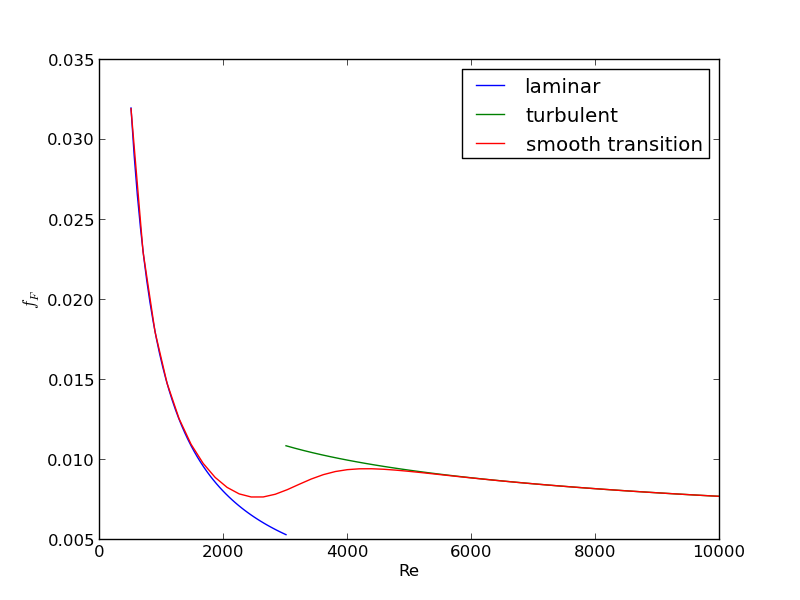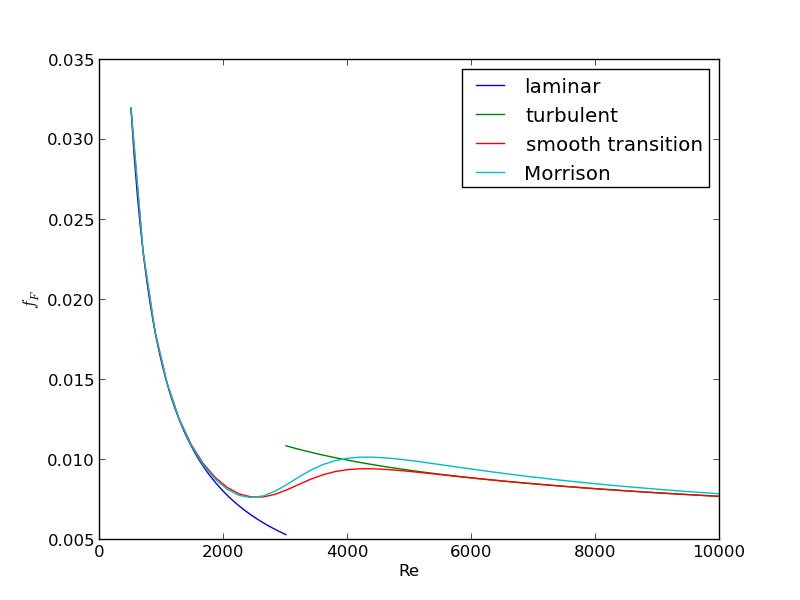Smooth transitions between discontinuous functions
Posted January 31, 2013 at 09:00 AM | categories: nonlinear algebra, miscellaneous | tags:
Updated March 06, 2013 at 06:25 PM
In Post 1280 we used a correlation for the Fanning friction factor for turbulent flow in a pipe. For laminar flow (Re < 3000), there is another correlation that is commonly used: \(f_F = 16/Re\). Unfortunately, the correlations for laminar flow and turbulent flow have different values at the transition that should occur at Re = 3000. This discontinuity can cause a lot of problems for numerical solvers that rely on derivatives.
Today we examine a strategy for smoothly joining these two functions. First we define the two functions.
import numpy as np from scipy.optimize import fsolve import matplotlib.pyplot as plt def fF_laminar(Re): return 16.0 / Re def fF_turbulent_unvectorized(Re): # Nikuradse correlation for turbulent flow # 1/np.sqrt(f) = (4.0*np.log10(Re*np.sqrt(f))-0.4) # we have to solve this equation to get f def func(f): return 1/np.sqrt(f) - (4.0*np.log10(Re*np.sqrt(f))-0.4) fguess = 0.01 f, = fsolve(func, fguess) return f # this enables us to pass vectors to the function and get vectors as # solutions fF_turbulent = np.vectorize(fF_turbulent_unvectorized)
Now we plot the correlations.
Re1 = np.linspace(500, 3000) f1 = fF_laminar(Re1) Re2 = np.linspace(3000, 10000) f2 = fF_turbulent(Re2) plt.figure(1); plt.clf() plt.plot(Re1, f1, label='laminar') plt.plot(Re2, f2, label='turbulent') plt.xlabel('Re') plt.ylabel('$f_F$') plt.legend() plt.savefig('images/smooth-transitions-1.png')
>>> >>> >>> >>> >>> <matplotlib.figure.Figure object at 0x051FF630> [<matplotlib.lines.Line2D object at 0x05963C10>] [<matplotlib.lines.Line2D object at 0x0576DD70>] <matplotlib.text.Text object at 0x0577CFF0> <matplotlib.text.Text object at 0x05798790> <matplotlib.legend.Legend object at 0x05798030>

You can see the discontinuity at Re = 3000. What we need is a method to join these two functions smoothly. We can do that with a sigmoid function. Sigmoid functions
A sigmoid function smoothly varies from 0 to 1 according to the equation: \(\sigma(x) = \frac{1}{1 + e^{-(x-x0)/\alpha}}\). The transition is centered on \(x0\), and \(\alpha\) determines the width of the transition.
x = np.linspace(-4,4); y = 1.0 / (1 + np.exp(-x / 0.1)) plt.figure(2); plt.clf() plt.plot(x, y) plt.xlabel('x'); plt.ylabel('y'); plt.title('$\sigma(x)$') plt.savefig('images/smooth-transitions-sigma.png')
>>> <matplotlib.figure.Figure object at 0x0596CF10> [<matplotlib.lines.Line2D object at 0x05A26D90>] <matplotlib.text.Text object at 0x059A6050> <matplotlib.text.Text object at 0x059AF0D0> <matplotlib.text.Text object at 0x059BEA30>

If we have two functions, \(f_1(x)\) and \(f_2(x)\) we want to smoothly join, we do it like this: \(f(x) = (1-\sigma(x))f_1(x) + \sigma(x)f_2(x)\). There is no formal justification for this form of joining, it is simply a mathematical convenience to get a numerically smooth function. Other functions besides the sigmoid function could also be used, as long as they smoothly transition from 0 to 1, or from 1 to zero.
def fanning_friction_factor(Re): '''combined, continuous correlation for the fanning friction factor. the alpha parameter is chosen to provide the desired smoothness. The transition region is about +- 4*alpha. The value 450 was selected to reasonably match the shape of the correlation function provided by Morrison (see last section of this file)''' sigma = 1. / (1 + np.exp(-(Re - 3000.0) / 450.0)); f = (1-sigma) * fF_laminar(Re) + sigma * fF_turbulent(Re) return f Re = np.linspace(500,10000); f = fanning_friction_factor(Re); # add data to figure 1 plt.figure(1) plt.plot(Re,f, label='smooth transition') plt.xlabel('Re') plt.ylabel('$f_F$') plt.legend() plt.savefig('images/smooth-transitions-3.png')
... ... ... ... ... ... ... ... >>> >>> >>> >>> ... <matplotlib.figure.Figure object at 0x051FF630> [<matplotlib.lines.Line2D object at 0x05786310>] <matplotlib.text.Text object at 0x0577CFF0> <matplotlib.text.Text object at 0x05798790> <matplotlib.legend.Legend object at 0x05A302B0>

You can see that away from the transition the combined function is practically equivalent to the original two functions. That is because away from the transition the sigmoid function is 0 or 1. Near Re = 3000 is a smooth transition from one curve to the other curve.
Morrison derived a single function for the friction factor correlation over all Re: \(f = \frac{0.0076\left(\frac{3170}{Re}\right)^{0.165}}{1 + \left(\frac{3171}{Re}\right)^{7.0}} + \frac{16}{Re}\). Here we show the comparison with the approach used above. The friction factor differs slightly at high Re, because Morrison's is based on the Prandlt correlation, while the work here is based on the Nikuradse correlation. They are similar, but not the same.
# add this correlation to figure 1 h, = plt.plot(Re, 16.0/Re + (0.0076 * (3170 / Re)**0.165) / (1 + (3170.0 / Re)**7)) ax = plt.gca() handles, labels = ax.get_legend_handles_labels() handles.append(h) labels.append('Morrison') ax.legend(handles, labels) plt.savefig('images/smooth-transitions-morrison.png')
>>> >>> >>> >>> >>> >>> >>> <matplotlib.legend.Legend object at 0x05A5AEB0>

1 Summary
The approach demonstrated here allows one to smoothly join two discontinuous functions that describe physics in different regimes, and that must transition over some range of data. It should be emphasized that the method has no physical basis, it simply allows one to create a mathematically smooth function, which could be necessary for some optimizers or solvers to work.
Copyright (C) 2013 by John Kitchin. See the License for information about copying.